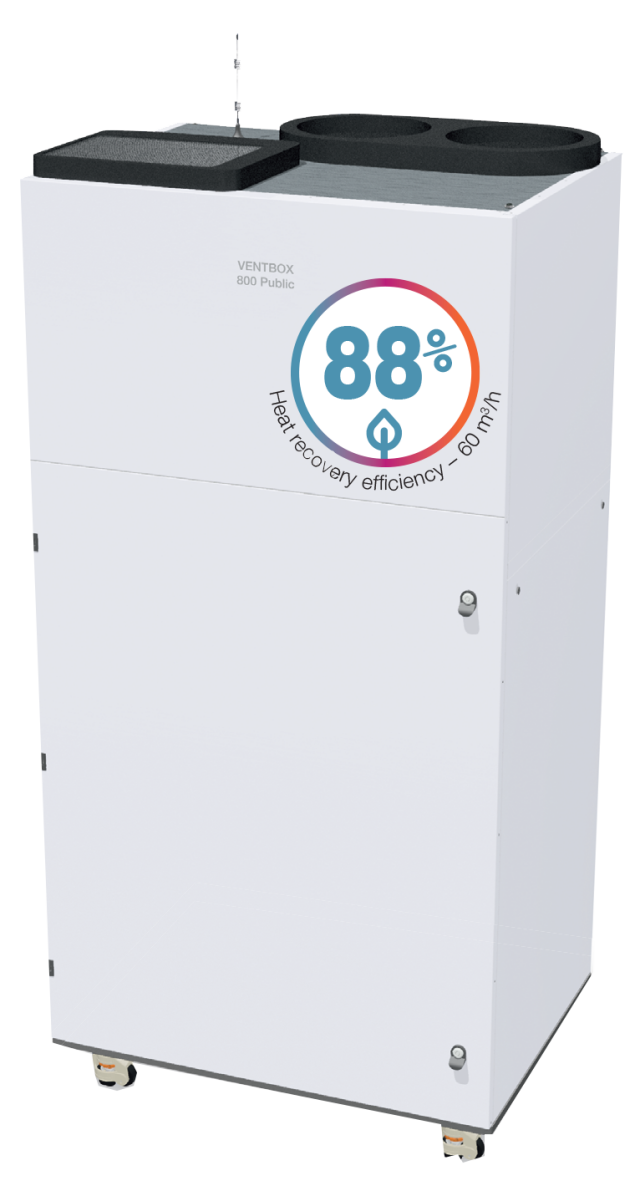VENTBOX 800 Public
Public buildings and schools up to 600 m²
The decentralized heat recovery unit VENTBOX 800 Public is designed for installation in enclosed spaces of school buildings and other public spaces. It meets strict hygienic limits for acoustic emissions and air filtration. Ventilation performance, low acoustic emissions, compact dimensions and efficient heat recovery allow installation even in buildings, where extensive air ducts cannot be built.
The VENTBOX 800 Public ventilation unit has its own solution for connecting exterior air inlets, for example through a window infill. The termination of air ducts on the outside of the building is always done with a requirement for aesthetic appearance and functionality. The ventilation unit is equipped with an efficient heat exchanger and reduces heat losses that occur during conventional ventilation ‘only by opening windows’ or other economically and technically unsuitable methods of ventilation. It ensures a permanent reduction in CO2 concentration and maximum elimination of outdoor odors using carbon filters and brings the comfort of fresh clean air. The installation of a unit with an enthalpy exchanger does not require connection to a waste pipe for condensate drainage.
- Efficient exhaust air removal
- Fresh air without allergens and pollen
- Radon-free house
| Recommended area | up to 600 m² | |
| Energy class | A+ | |
| Installation option | Floor mounting | |
| Dimensions (h × w × d) | 2 050 × 1 005 × 740 mm | |
| Weight [kg] | 152 kg | |
| Voltage | 230 V AC/50 Hz | |
| Electric current without preheating [A] | 1.5 A | |
| Electric current including preheating [A] | 12 A | |
| Max. input power of the unit without preheating [W] | 318 W | |
| Max. preheating input power [W] | 2 550 W | |
| IP coverage | 30 | |
| Air flow [m³/h] | 120–800 m³/h | |
| Maximum airflow in BOOST setting [m³/h] | 800 m³/h | |
| Reference air flow [m³/h] | 560 m³/h | |
| Displacement pressure [Pa] | 50–100 Pa | |
| Acoustic energy LWA [m³/h/Pa/dB] | 560 m³/h/50 Pa/39 dB | |
| Heat transfer efficiency / Flow rate | 82 %/800 m³/h; 82 %/560 m³/h; 81 %/120 m³/h | |
| Electrical input (without preheating) | 263 W/800 m³/h; 105 W/560 m³/h; 20 W/120 m³/h | |
| ∅ of the connection necks [mm] | 250 mm | |
| Type of pipe for condensate drainage | HT DN 32 mm | |
| Specific power consumption SPI | 0,19 W/m³/h | |
| Max. number of all sensors (CO2 / RH / RADON …) | 9 | |
| Connector for fire sensor or EPS connection | Yes | |
| Automatic frost protection | Yes | |
| Bypass function (exchanger bypass) | Yes | |
| Shock ventilation | Yes | |
| Weekly time mode | Yes | |
| Measuring energy consumption | Yes | |
| Modbus TCP/IP communication | Yes | |
| Modbus RTU communication | Yes | |
| Analogue input | 2 | |
| Digital input | 1 | |
| EC motors with a constant flow function | Yes | |
| Filter clogging indicator based on time interval | Yes | |
| Wire pre-filter | Yes | |
| Filter clogging indicator based on filter pressure drop | Yes | |
| Filters supply/exhaust (% of particles captured in a given filter class) | F7 pollen/odour ePM1 70 % (F7 AC optional) | |
ORDERING CODES
Example of ordering code: VB1-0800-PD-PHL
VENTBOX 800 Public, a first-generation unit for decentralized air distribution, EC constant flow motors Premium version, with standard counterflow plate heat exchanger and left-hand side connection.
| VENTBOX | Generation | | Volume flow | | Design | Heat recovery unit type | | Model / Type | Exchanger type | Connection option |
|---|---|---|---|---|---|---|---|---|---|---|
| V B | 1 | - | 0800 | - | P | D | - | P | H | L |
| | | | | | Public | Decentralized | | P - Premium | H - standard E - enthalpy | L - left |
Contact us
For more information, do not hesitate to contact us
